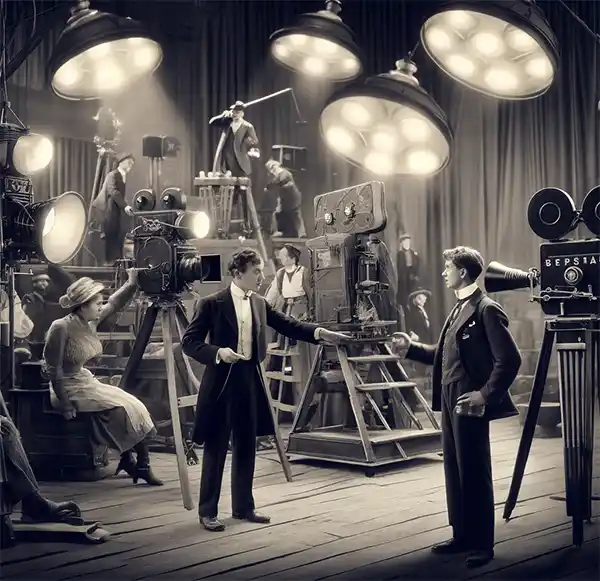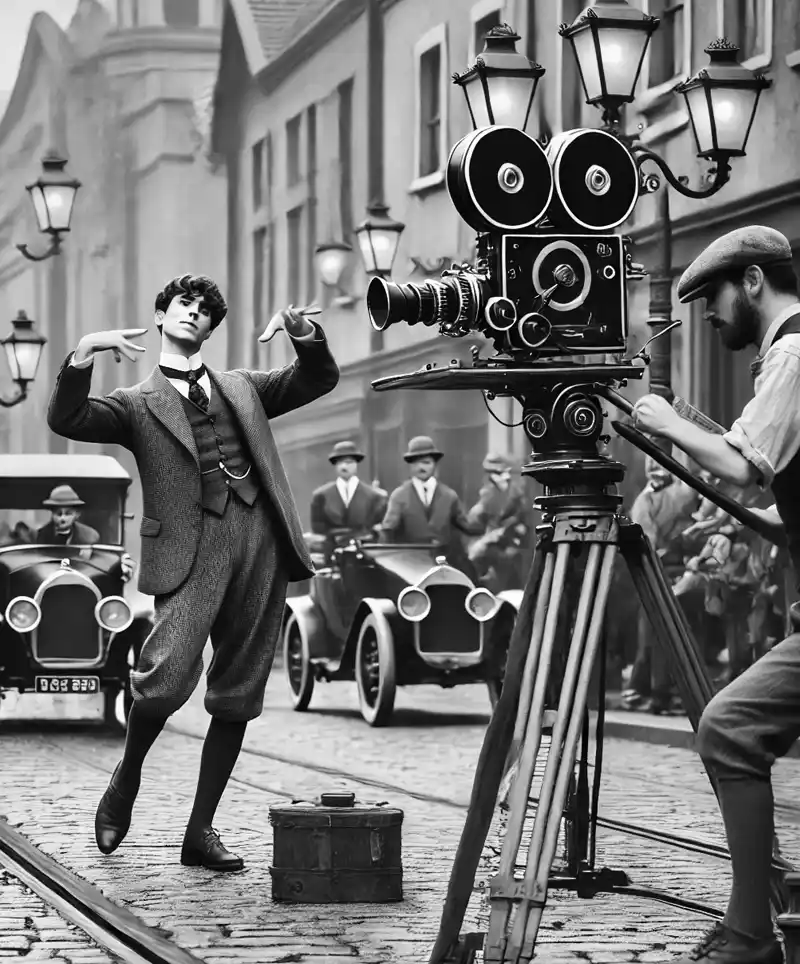A Journey Back to Cinema’s Quiet Masterpieces
In a world where soundtracks, dialogue, and special effects dominate the silver screen, it can be easy to forget that cinema was once completely silent. Before the invention of synchronized sound, filmmakers relied on visual storytelling, expressive acting, and imaginative direction to captivate audiences. National Silent Movie Day, observed on September 29th, is a day to celebrate these pioneering films that laid the foundation for modern cinema.
The Origins of Silent Film
Silent movies date back to the late 19th century when inventors like Thomas Edison and the Lumière brothers were experimenting with early motion picture technology. The very first films were short and simple—a train arriving at a station, people leaving a factory, or scenes of everyday life. These were known as “actualities,” and though they lacked narrative structure, they sparked the world’s fascination with moving pictures.
 As the technology evolved, filmmakers began exploring storytelling. By the early 1900s, silent films were incorporating more complex narratives and a new form of entertainment was born. Directors like Georges Méliès (with his 1902 classic A Trip to the Moon) pushed the boundaries of what could be achieved on screen, using creative effects and sets to transport audiences to otherworldly places.
As the technology evolved, filmmakers began exploring storytelling. By the early 1900s, silent films were incorporating more complex narratives and a new form of entertainment was born. Directors like Georges Méliès (with his 1902 classic A Trip to the Moon) pushed the boundaries of what could be achieved on screen, using creative effects and sets to transport audiences to otherworldly places.
How Silent Movies Told Stories
Without spoken dialogue, silent films relied heavily on visuals, physical acting, and intertitles (text displayed between scenes) to convey the plot and emotions. The actors, many of whom came from stage backgrounds, had to be incredibly expressive. Their exaggerated facial expressions and gestures conveyed the depth of their characters’ emotions in a way that transcended language barriers.
Cinematography also played a critical role in silent storytelling. Directors used camera angles, lighting, and framing to emphasize mood and guide the viewer’s attention. Music, often performed live in theaters by pianists or small orchestras, provided emotional cues to enhance the viewing experience. The result was a form of pure cinema—visual storytelling at its finest.
Silent Movie Icons
The silent era gave rise to some of the most iconic figures in film history, whose work continues to be celebrated today.
- Charlie Chaplin: Perhaps the most famous silent movie star of all time, Chaplin’s character, The Tramp, captured hearts with his blend of comedy and pathos. Films like City Lights and The Gold Rush are still considered masterpieces of the silent era.
- Buster Keaton: Known as the "Great Stone Face" due to his stoic expression, Keaton was a master of physical comedy. His daring stunts and inventive sight gags in films like Sherlock Jr. and The General remain jaw-dropping even by today’s standards.
- Mary Pickford: One of the first true movie stars, Pickford’s girl-next-door persona made her a favorite among silent film audiences. Dubbed “America’s Sweetheart,” she was a box office powerhouse and helped shape the early Hollywood industry.
- Rudolph Valentino: A symbol of the romantic leading man, Valentino’s smoldering good looks and performances in films like The Sheik made him a global sensation.
The End of the Silent Era
The era of silent films came to an abrupt end with the introduction of synchronized sound in the late 1920s, a monumental shift in the film industry that changed the course of cinema forever. The release of The Jazz Singer in 1927, featuring synchronized dialogue and musical numbers, is widely considered the turning point. This was the first commercially successful "talkie," and its popularity signaled the dawn of a new era—one where audiences no longer had to rely solely on intertitles, musical scores, and exaggerated expressions to follow the plot.
While the advent of sound was revolutionary, it was also a death knell for many careers in the silent film industry. The transition wasn’t smooth for all actors and filmmakers. Some of the biggest stars of the silent era, like Charlie Chaplin, managed to adapt, though he initially resisted the change. Chaplin famously delayed the inclusion of synchronized dialogue in his films, releasing City Lights in 1931 as a silent film, even though the technology for talkies was readily available.
However, other silent film stars were not as fortunate. John Gilbert, one of the biggest heartthrobs of the silent screen, saw his career decline rapidly with the advent of sound. Whether it was his voice not suiting the new format or simply poor studio management, Gilbert became a cautionary tale of how quickly fortunes could change in the volatile world of Hollywood.
Beyond actors, filmmakers also faced challenges with the technical complexities that sound introduced. Directors who had mastered visual storytelling now had to contend with bulky sound equipment, stationary microphones, and rethinking how to incorporate dialogue into their carefully crafted scenes. Many early sound films felt clunky as studios experimented with the new medium, often sacrificing the fluid, dynamic cinematography of the silent era for stilted, dialogue-heavy scenes.
Yet, despite these growing pains, the appeal of "talkies" was undeniable. Audiences were thrilled to finally hear their favorite stars speak, and studios quickly invested in sound technology, leaving silent films in the dust. The Hollywood landscape changed almost overnight, with talkies dominating the box office by the end of the decade. The 1930 Academy Awards even created a separate category for "Best Artistic Quality of Production" (won by Sunrise), recognizing that silent films still held merit, though their time was clearly coming to an end.
Though the curtain fell on the silent era, the innovations of silent cinema—its techniques in visual storytelling, physical comedy, and emotion without words—left a lasting legacy. The transition to sound may have been inevitable, but the silent film era's contributions remain a foundational part of film history.
Preserving Silent Films
One of the greatest challenges with silent films is preservation. The fragile nature of early film stock means that many silent movies have been lost to time, either through decay or accidental destruction. It’s estimated that around 75% of silent films are now considered lost, making preservation efforts crucial for saving what remains of this era.
Organizations like the Library of Congress, The Film Foundation, and The Silent Film Society of Chicago are dedicated to preserving and restoring silent films. They work tirelessly to locate, restore, and digitize these films, ensuring that future generations can enjoy and learn from them. National Silent Movie Day itself plays a part in raising awareness of the importance of preserving these cultural treasures.
The Timeless Appeal of Silent Films
Though silent films are often overshadowed by modern blockbusters, there is something timeless about the era’s visual storytelling. Watching a silent movie is like opening a window into the past—a chance to see the world through the eyes of early filmmakers who had to innovate in ways we take for granted today. In many ways, silent films are pure cinema, relying entirely on images, actions, and music to communicate their stories.
Silent films also have a universal appeal. Without language barriers, they can be enjoyed by people all over the world. The emotions conveyed on screen—joy, sorrow, fear, love—are as relatable today as they were a century ago.
Celebrating National Silent Movie Day
On National Silent Movie Day, film enthusiasts and historians come together to celebrate this pivotal period in cinema history. Events may include screenings of restored silent films, live performances of musical scores, and discussions on the impact of silent cinema. Many theaters and streaming services showcase classic silent films, giving new audiences the chance to experience these cinematic gems.

Whether you're a seasoned cinephile or a curious newcomer, watching a silent movie is a chance to witness the magic of storytelling without the distractions of modern technology. It’s a reminder of the creativity, craftsmanship, and emotion that have always been at the heart of filmmaking.
So, this National Silent Movie Day, why not step back in time and watch a film from the silent era? You might just find yourself charmed by the expressive faces, dazzling stunts, and heartfelt stories that continue to resonate, even without a single word spoken.
Please Share our Content






 As the technology evolved, filmmakers began exploring storytelling. By the early 1900s, silent films were incorporating more complex narratives and a new form of entertainment was born. Directors like Georges Méliès (with his 1902 classic A Trip to the Moon) pushed the boundaries of what could be achieved on screen, using creative effects and sets to transport audiences to otherworldly places.
As the technology evolved, filmmakers began exploring storytelling. By the early 1900s, silent films were incorporating more complex narratives and a new form of entertainment was born. Directors like Georges Méliès (with his 1902 classic A Trip to the Moon) pushed the boundaries of what could be achieved on screen, using creative effects and sets to transport audiences to otherworldly places.









 "Sláinte!" is a traditional Irish expression used as a toast, equivalent to "Cheers!" in English.
"Sláinte!" is a traditional Irish expression used as a toast, equivalent to "Cheers!" in English.